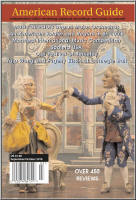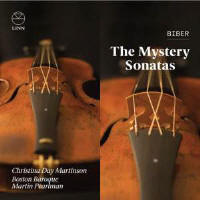Texte paru dans: / Appeared in: |
|
|
Outil de traduction ~ (Très approximatif) |
|
|
Reviewer: Charles
Brewer To date there have been about 30 recordings of Heinrich Ignaz Franz von Biber’s so-called Mystery or Rosary Partitas (Biber never titled them “sonatas”), and 15 have been reviewed in ARG. This new release from Christina Day Martinson, accompanied Martin Pearlman (hpsi & org), Michael Unterman (vc), and Michael Leopold (theorbo & g), follows on a number of concert performances of the cycle and an extensive marketing campaign. Martinson has a strong technique, but there is a lack of variety in her tone. Partly this may be owing to the close studio recording, which also enhances the scratch of the bow against the strings, especially on the G string. This might not be so evident in concert, but over the course of the two hours of this recording it becomes a bit wearing on my ears. I also noted a tendency to quickly break the double, triple, and quadruple stops, almost always from the bottom up. This limits the harmonic sonority of those chords and sometimes overemphasizes melody over bass. This is very evident in the final unaccompanied Passacaglia. Her performance of the double stops also limits the perception of the syncopations, which are thematically important in the opening imitative section of II: Visitation of Mary to Elizabeth. My general impression is of a performance that is reserved and careful, but with no variety in the string sound. I would like a more musical phrasing and pacing, especially in the long variation movements. There are tasteful ornaments added by Martinson to most of the dance movements, but these seem less evident in the later partitas. It is an interesting addition that Martinson plays the open strings before each piece, since the different scordatura (retuning) is important. But I would have separated these somehow, because the tuning of the strings is not always tonally related to the opening of the individual Mysteries. It was especially jarring in VI: Suffering of Christ on the Mount of Olives, where the scordatura outlines the pitches of A-flat, E-flat, G, and D (from the bottom string to the top), but the sonata begins on a C-minor chord. There are also a number of questionable interpretations here. In IV: Presentation of esus at the Temple she introduces a sul ponticello in the Ciacona, I presume for variety. This was earlier used as a special effect in Carlo Farina’s programmatic Capriccio Stravagante (1627), but I do not see any reason for its use here. There are a number of places where she does not follow the articulation marks or dynamics in the single extant manuscript or the modern critical editions.
A number of these problems are
emphasized in XI: The Resurrection, the sonata with the most extreme
scordatura, where the position of the two middle strings needs to be
exchanged so that they “cross” over each other. There are some missed dynamic contrasts, but it is the set of variations on the song, ‘Surrexit Christus hodie’ that demonstrates a lack of care. Martinson breaks up the song’s melody as if she has no idea of its text or phrasing—which would be quite evident to Biber’s listeners, since the song was well known in both Latin and German. There is one passage of triple stops where she plays incorrect pitches. Towards the end of the movement, where the scordatura allows the violinist to play parallel octaves that would otherwise be impossible, she apparently was following the manuscript, but as almost every modern editor has pointed out, there are mistakes in the copyist’s work that change the tune without reason and again would have been evident to the performers of Biber’s time. Lastly, this interpretation ends this set of variations quietly.
In almost every case where Biber or his contemporaries write passages in octaves or unisons it is for increased emphasis; I would even question whether the continuo should include harmonies for this passage, because the manuscript does not even include a figured bass for this passage. More important, it appears that no one took the time to look at the end of the text for this song, which I would translate as follows: “(13) In this Pascal joy, alleluja, Let us bless the Lord, alleluja. (14) Glory to you, O Lord, alleluja, Who arose from the dead, alleluja. (15) May the Holy Trinity be praised, alleluja, Let us declare thanks to God, alleluja.” I know of no other composition by Biber or his contemporaries that would underplay the joy and exultation of the Easter declaration made by this song.
Before attempting the 15 Mystery Partitas, more violinists should engage and learn from Biber’s 1681 violin sonatas (one of which also includes a scordatura). There is strong evidence that the Mystery Partitas were written later than the 1681 sonatas, and learning the earlier pieces would supply a stronger foundation for the performance of the Partitas, especially the technical problems associated with the extreme retunings. I most missed here a clear understanding of the spiritual meaning of each of these Mysteries. Though it too has blemishes, Pavlo Beznosiuk more clearly engaged the spiritual dimension (J/F 2005), and even Rachel Podger (M/J 2016) has a more meditative quality. Though I am waiting for the arrival of two further recordings, at the moment I still recommend Daniel Sepec (Mar/Apr 2011).
| |
|
|
|
|
Cliquez l'un ou l'autre
bouton pour découvrir bien d'autres critiques de CD |
|




